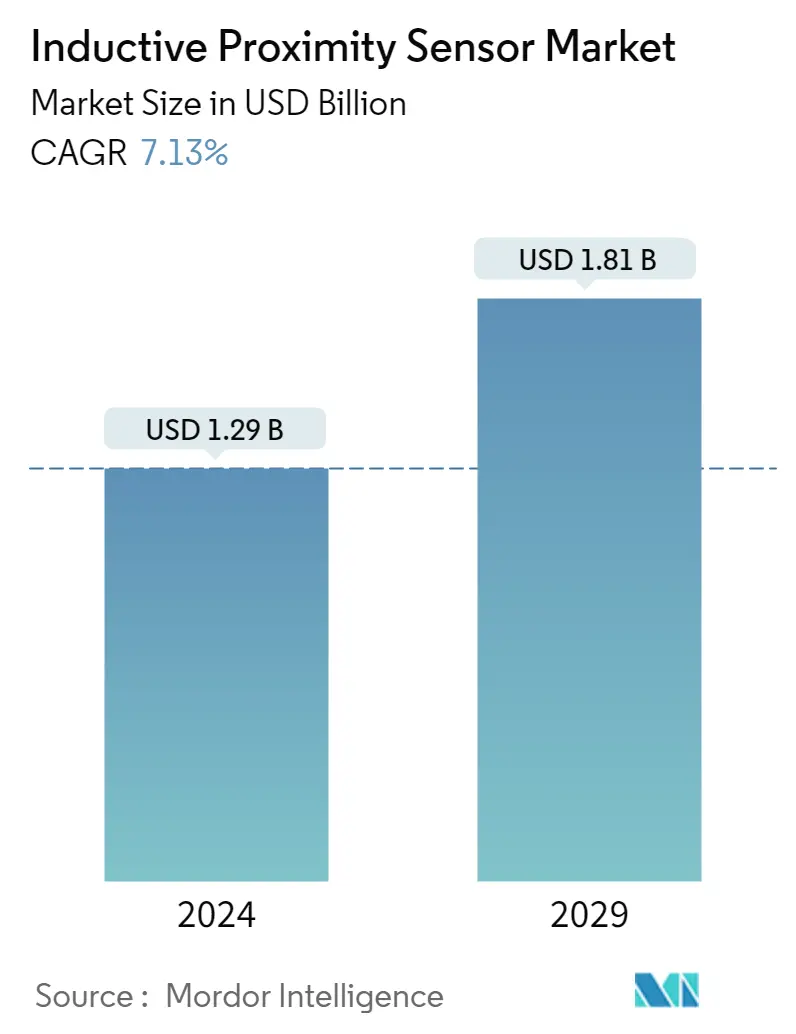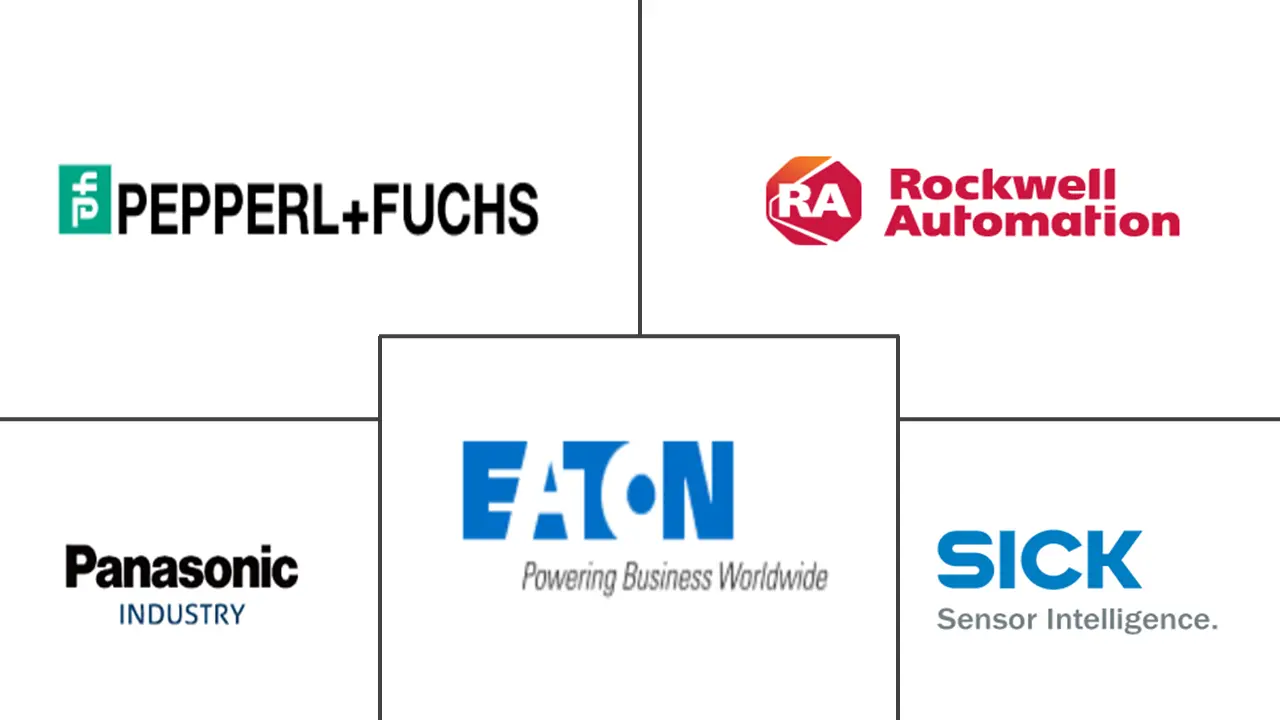Market Size of Inductive Proximity Sensor Industry

| Study Period | 2019 - 2029 |
| Market Size (2024) | USD 1.29 Billion |
| Market Size (2029) | USD 1.81 Billion |
| CAGR (2024 - 2029) | 7.13 % |
| Fastest Growing Market | Asia-Pacific |
| Largest Market | Asia-Pacific |
| Market Concentration | Low |
Major Players
*Disclaimer: Major Players sorted in no particular order |
Inductive Proximity Sensors Market Analysis
The Inductive Proximity Sensor Market size is estimated at USD 1.29 billion in 2024, and is expected to reach USD 1.81 billion by 2029, growing at a CAGR of 7.13% during the forecast period (2024-2029).
Inductive proximity sensors are non-contact devices that set up a radio frequency field with a coil and an oscillator. The presence of an object can alter this field, and the sensor can detect this alteration. The inductive proximity sensors can detect an object without touching it and therefore do not cause damage or abrasion to the object.
- Proximity sensors are generally used in many automation applications. They are used to sense objects and do not require physical contact with the target or object being sensed. Thus, they are referred to as non-contact sensors. The common proximity sensor types include photoelectric, capacitive, and inductive sensors.
- Inductive proximity sensors are utilized for the non-contact detection of metallic objects. The operating principle of these sensors is based on the coil and oscillator, which creates an electromagnetic field in the near surroundings of the sensing surface. Proximity sensors are also found in consumer devices. In smartphones, proximity sensors detect if a user is holding the mobile near their face.
- With ASIC technology, SICK sensors provide enhanced precision and reliability. The company can offer the right solution to meet the customer's requirements every time, from cuboid standard sensors or cylindrical, with single, double, or triple operating distances, to special sensors for use in explosive and toxic atmospheres or harsh environments. The company's inductive proximity sensors are the intelligent, reliable route to implementing industry-specific and customized to any task involving automation.
- In the case of conventional inductive proximity sensors, if the distance to the damping element increases, the sensor becomes more sensitive to the detection object, and the metal surrounding the installation affects the switching distance.
- To tackle this issue, Pepperl+Fuchs has introduced active shielding technology, which enables high switching distances regardless of the installation conditions. The company has integrated it into the VariKont series for the first time. They are available in versions with high switching distances of 30 mm for flush mounting and 50 mm for non-flush mounting.
- The inductive proximity sensors are used in several industrial and manufacturing applications for safety and inventory management applications. An automated production line, for example, is used for positioning, object detection, counting, and inspection. The proximity sensors are also used for part detection in several industrial conveyor systems.
- The need to withstand harsh cleaning agents, severe temperatures, and high-pressure wash-down environments is compelling the food and beverage industry to adopt proximity sensors. In the food and beverage sector, applications like food production and harsh chemicals are used during cleaning, where a standard sensor will corrode and fail prematurely. The inductive proximity sensor exhibits a robust design with superior resistance to high temperature and high-pressure cleaning processes.
Inductive Proximity Sensors Industry Segmentation
An inductive proximity sensor detects or measures objects using the principle of electromagnetic induction. Furthermore, sensors can detect or measure objects without any physical contact with the target. The inductive proximity sensors have been increasingly finding their applications in automated assembly lines, weld cells, and stamping processes. The high accuracy and low-cost characteristics are fueling the adoption of inductive proximity sensors in various automation processes in industries such as oil and gas, packaging, automotive, food and beverage, and consumer electronics, among others.
The study on the inductive proximity sensor market analyzes the market across various end-user industries, including industrial, automotive, aerospace and defense, packaging, and various geographies.
The inductive proximity sensor market is segmented by end-user application (industrial, automotive, aerospace and defense, packaging, and end-user applications) and geography (North America, Europe, Asia-Pacific, and Latin America).
The market sizes and forecasts are provided in terms of value (USD million) for all the above segments.
| By End-user Application | |
| Industrial | |
| Automotive | |
| Aerospace and Defense | |
| Packaging | |
| Other End-user Applications |
| By Geography | ||||||
| ||||||
| ||||||
| ||||||
| Latin America | ||||||
| Middle East and Africa |
Inductive Proximity Sensor Market Size Summary
The inductive proximity sensors market is poised for significant growth, driven by their increasing application in automation and industrial processes. These non-contact sensors, which detect metallic objects without physical contact, are essential in various sectors, including manufacturing, automotive, and consumer electronics. Their ability to operate in harsh environments, such as those found in the food and beverage industry, where they resist high temperatures and corrosive cleaning agents, makes them invaluable. The market is characterized by the presence of both small and large players, with companies like Panasonic Corporation, Sick AG, and Pepperl+Fuchs leading the charge in innovation and technology advancements. The integration of ASIC technology and active shielding solutions has further enhanced the precision and reliability of these sensors, catering to diverse industrial needs.
The Asia-Pacific region is expected to experience robust growth in the inductive proximity sensors market, fueled by the rapid industrialization in countries like China and India. The region's prominence is bolstered by the presence of major vendors and the increasing demand for electric vehicles, which necessitates advanced sensing solutions for mixed material production lines. Additionally, initiatives like the Production Linked Incentive Scheme in the automotive sector are set to boost domestic manufacturing, further driving market expansion. The competitive landscape of the market is marked by strategic partnerships and product innovations, such as Rockwell Automation's collaboration with Bravo Motor Company and Carlo Gavazzi's introduction of new sensor models, which are tailored for both indoor and outdoor applications.
Inductive Proximity Sensor Market Size - Table of Contents
-
1. MARKET INSIGHTS
-
1.1 Market Overview
-
1.2 Industry Attractiveness - Porter's Five Forces Analysis
-
1.2.1 Bargaining Power of Suppliers
-
1.2.2 Bargaining Power of Consumers
-
1.2.3 Threat of New Entrants
-
1.2.4 Threat of Substitutes
-
1.2.5 Intensity of Competitive Rivalry
-
-
1.3 Impact of COVID-19 on the Inductive Proximity Sensor Market
-
-
2. MARKET SEGMENTATION
-
2.1 By End-user Application
-
2.1.1 Industrial
-
2.1.2 Automotive
-
2.1.3 Aerospace and Defense
-
2.1.4 Packaging
-
2.1.5 Other End-user Applications
-
-
2.2 By Geography
-
2.2.1 North America
-
2.2.1.1 United States
-
2.2.1.2 Canada
-
-
2.2.2 Europe
-
2.2.2.1 United Kingdom
-
2.2.2.2 Germany
-
2.2.2.3 France
-
2.2.2.4 Rest of Europe
-
-
2.2.3 Asia-Pacific
-
2.2.3.1 China
-
2.2.3.2 Japan
-
2.2.3.3 India
-
2.2.3.4 Rest of Asia Pacific
-
-
2.2.4 Latin America
-
2.2.5 Middle East and Africa
-
-
Inductive Proximity Sensor Market Size FAQs
How big is the Inductive Proximity Sensor Market?
The Inductive Proximity Sensor Market size is expected to reach USD 1.29 billion in 2024 and grow at a CAGR of 7.13% to reach USD 1.81 billion by 2029.
What is the current Inductive Proximity Sensor Market size?
In 2024, the Inductive Proximity Sensor Market size is expected to reach USD 1.29 billion.

